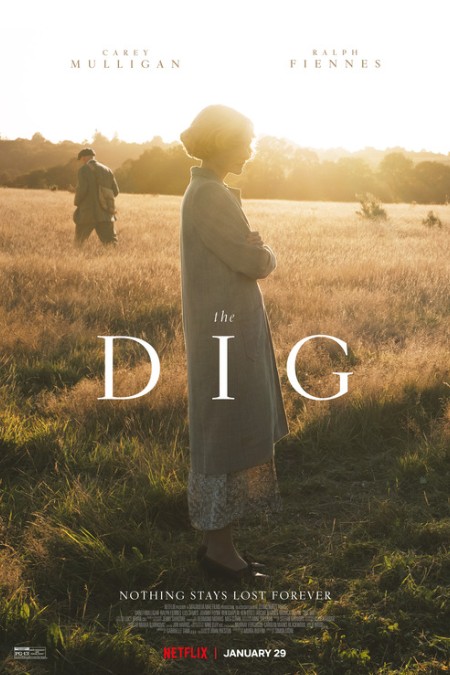
Archaeological are by their very nature spectacularly impressive things.
Whether it is the discovery of First Nations art in the Kimberleys that is tens of thousands of years old or, for the purpose of this review, an Anglo Saxon ship and gold artifacts in Suffolk, we can’t help but be thrilled by the lifting of the veil of lives long ago lived and now gone.
But once thing that is often lost in the justifiable excitement over these discoveries are the lives of those who are instrumental in brings these signs of ancient humanity back to the forefront of human existence.
People like amateur archaeologist/excavator Basil Brown (Ralph Fiennes) and Edith Pretty (Carey Mulligan) who, as detailed in The Dig, made one of the greatest discoveries in British archaeological history in 1939, on the eve of World War Two when they dug into burial mounds on Edith’s sprawling estate at Sutton Hoo near Woodbridge and found a burial ship, at first thought to date to the Viking era.
But the consequential unearthing of items such as gold coins and iron helmets by a team which came to include Peggy Piggott (Lily James) and Charles Phillips (Ken Stott) from the British Museum moved the dating of the ship back to the 6th century A.D., in the process revealing that the Dark Ages were apparently not so dark and culturally deficient after all.
The unearthing of this treasure trove was impressive by any yardstick and The Dig, directed by Simon Stone to a screenplay by Moira Buffini, is careful to give the Sutton Hoo discoveries all the adulation they deserve.
But the real quite joy of this artfully realised film is the way in which it takes great care and empathy to delve into the lives of Edith, Basil, Peggy and a number of other key players to give us rich and affecting insight, as filtered through a Hollywood lens but still movingly human nonetheless, into what it was like to be involved in such a major archaeological moment.
What is captivating about The Dig, which moves in nuanced, thoughtful steps as conscious of who something is happening to as much as what is happening – this applies as much to the illness that besets Edith or the lack of recognition that bedevils Basil as much as the unearthing of the mound itself – is how beautifully it tells its wholly engaging story.
While it sticks to a largely linear route for its narrative, it plays around with the idea that every scene must proceed in its entirety before another can take its place.
Or that one conversation has to happen before we can bear witness to another, which plays out in the final act where a clearly distressed Edith is sitting on her bed comforting her son Robert (Archie Barnes), who has grown quite close to Robert as he accompanies him to the dig site more often than not, who is worried that his mother is going to die just like his father did just as Peggy and Edith’s cousin Rory (Johnny Flynn), the photographer on the dig, are consummating their slowly burbling attraction.
In that one exquisitely well-realised split scene, we see both an end of sorts, or a possible end and a beginning, testament to the duality of life which defies any idea often of neat tidy starts and finishes to the wholly messy business of living.
This gloriously moving scene, where the dialogue seems to run disembodied from the characters themselves, lending an air of things happening and having happened simultaneously, is emblematic of the poetical storytelling style of The Dig which employs a liberatingly unorthodox sensibility and visual and narrative style in the midst of an otherwise conventional film.
It’s an approach that is both beautifully and deeply affecting, exploring how no matter these finds may be, that they never happen in a vacuum and that as the people of the past are finding recognition and voice again, much the same is happening to the people involved in their long-delayed reintroduction to the world.
The Dig benefits from its willingness to let the story take its time being told.
While there are some high adrenaline moments and a sense of mounting urgency that the dig must be finished before war breaks out, when of course all of the civilian priorities of peace cease to have any weight or meaning, such as the announcements of great discoveries in the mound or the perilous event faced by one of the key characters, The Dig is largely to let things unfurl in their own good time.
This go-it-slow approach, which is reflected in the gorgeous lighting choices and laidback visual feel of cinematographer Mike Eley, does not happily sap the film of its emotional import.
All of the issues that face the central characters, and they are allowed to build and build to some kind of resolution, are deeply affecting in their own, sometimes melodramatic way, and we are left in no doubt that a relaxed narrative does not an emotionless effect make.
It all comes together in a film that, while it plays merry with the exact facts of the true story – Edith is sometimes 15 years younger in the film, for instance, that she was in real life – does a commendable job of showing how the archaeological glories we love to soak ourselves in do have a human side and a vital one at that.
Basil remarks at one point that digging up the past shows that we are all part of a continuous story and that even when we die, we live on because we are connected by our very humanity to that narrative, a remarkably insightful perspective that permeates The Dig which might celebrate the unveiling of the long-buried old but which nevertheless keeps its focus on the here and now where we, the heirs to the past, are finding our own finite ways to leave our mark.

